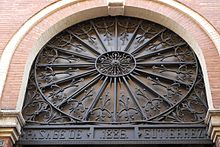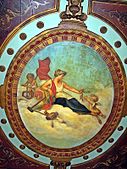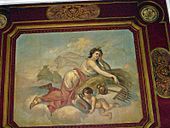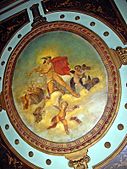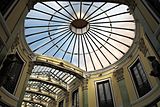Pasaje Gutierrez
The Pasaje Gutierrez in Valladolid , capital of the eponymous province in the Spanish autonomous community of Castile and Leon , is a shopping arcade from the 19th century. The passage connects Calle Fray Luis de León and Calle Castelar streets. It was built based on the model of the shopping malls in Paris , where the first passages ( Passage du Caire , Passage des Panoramas ) were built in the late 18th century . Most of the passages were - like the Galerie Vivienne , the Galerie Colbert or the Galerie Véro-Dodatin Paris, the Pommeraye passage in Nantes or the Galeries Royales Saint-Hubert in Brussels - laid out in the first half of the 19th century. In the second half of the 19th century, the magnificent Galleria Vittorio Emanuele II in Milan and the Galleria Umberto I in Naples followed. The Pasaje Gutiérrez is one of the few surviving passages in Spain with the Pasaje de Lodares in Albacete , a provincial capital in the autonomous region of Castile-La Mancha , and the Pasaje del Ciclón in Saragossa , the capital of Aragón . In 1998 the Pasaje Gutiérrez was declared a monument ( Bien de Interés Cultural ).
history
The passage goes back to the initiative of the merchant Eusebio Gutiérrez, who commissioned the architect Jerónimo Ortiz de Urbina to build it in 1885. The shopping arcade was supposed to connect the streets around the Cathedral Nuestra Señora de la Asunción with the area around the Plaza Mayor. In the middle of the 19th century, numerous cafes and shops had settled there and the shops in the new Passage Gutiérrez were intended to attract the middle and upper class. After less than a year of construction, the passage was inaugurated in 1886. However, due to a lack of success, it was abandoned a few years after its completion and was left to decay for almost a hundred years until it was restored by the city of Valladolid in the 1980s and revived by the settlement of cafes and pubs in particular.
architecture
The external facades are made of brick . The passage is divided into two sections with a rotunda in the middle . The iron roof structure is supported by decorated wooden beams and covered by a glass roof. The glass originally came from the Real Fábrica de Cristales de La Granja (Royal Glass Manufactory) in San Ildefonso in the province of Segovia . At the point where the passage is built over by apartments, it is spanned by a wooden ceiling with paintings using the fresco technique . The scenes, allegorical representations of industry, agriculture and trade, were executed by the local painter Salvador Seijas.
The shops on the ground floor have large shop windows. The apartments above, which open onto the passage, have beautiful bars on the windows. The female figures on the walls of the rotunda represent the four seasons. In the center is Mercury , the god of trade, a replica of the famous sculpture by Jean de Boulogne from 1580. On the balcony facing the building When Calle Fray Luis de León opens to the passage, two children are shown holding a large clock. Lamp holders made of bronze are attached to the walls. Originally, gas lighting ensured uniform brightness.
literature
- Alfredo J. Ramos: Castilla y León . Guía Total. Grupo Anaya, Madrid 2009, ISBN 978-84-9776-446-9 , p. 409.
Web links
- Pasaje Gutiérrez valladolid.portaldetuciudad.com
- Pasaje Gutiérrez valladolid.com
Individual evidence
- ↑ Pasaje Gutiérrez Ministerio de Educación, Cultura y Deporte (Spanish, accessed December 14, 2016)
Coordinates: 41 ° 39 ′ 4.9 " N , 4 ° 43 ′ 29.4" W.
